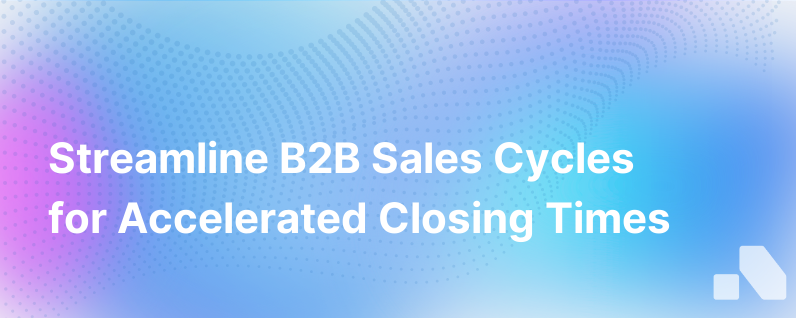Optimizing B2B Sales Cycles for Faster Closing
Published on December 1, 2023 by Sawyer Middeleer
In today's highly competitive B2B landscape, efficient sales cycle management is not just advantageous; it's imperative. An optimized sales cycle can mean the difference between a closed deal and a missed opportunity. As businesses seek to convert leads into customers more swiftly, understanding and streamlining the B2B sales process becomes a focal point for achieving growth and client acquisition targets.
The sales cycle, which spans the journey from an initial lead to a finalized deal, includes several stages: prospecting, connecting, researching, presenting, handling objections, closing, and nurturing. To foster faster closings, each of these stages must be meticulously understood and effectively managed.
The Power of Streamlined Processes
Streamlining processes is pivotal. By identifying inefficiencies and implementing improvements such as automating repetitive tasks, sales teams can dedicate more time to engaging with potential clients. Automation tools, such as customer relationship management (CRM) systems, can handle data entry, lead scoring, and follow-up scheduling, which not only accelerates the cycle but also ensures no lead goes unattended.
Lead Qualification: A Gatekeeper for Efficiency
One of the pillars of optimizing sales cycles is thorough lead qualification. Qualifying leads at the outset with clear discussions about solutions and budget expectations ensures that sales professionals focus their efforts on prospects with genuine interest and purchasing power. Techniques like the BANT framework—which assesses Budget, Authority, Need, and Timeline—can be integral in assessing lead quality early on.
Leveraging Data to Personalize and Predict
Furthermore, the utilization of data analytics enhances the sales cycle. Advanced CRM systems and artificial intelligence (AI) perform real-time data analysis, offering tailored recommendations and predictive insights, thereby sharpening the sales team's approach. The power of data can be harnessed to not only personalize the sales pitch but also to predict which leads are most likely to convert, thus aiding in prioritization.
Speed and Precision: The Essence of Proposal Generation
Once a lead has been qualified, the proposal stage becomes crucial. Modern sales teams leverage exemplary proposals that offer clear explanations of value propositions, tailored responses to specific client needs, and exact details on how their solution solves pressing problems. Quick, yet customized proposals can significantly influence the duration of the sales cycle.
Mutual Action Plans: Charting the Course Together
Another innovative approach is sharing a Mutual Action Plan (MAP) with the prospect. MAPs outline the steps to a successful partnership, serving as a shared roadmap. They facilitate open communication, set expectations, and create accountability, leading to more decisive actions and, thus, moved to close.
Nurturing Relationships for Long-term Success
Optimizing B2B sales cycles also means looking beyond the immediate close. Nurturing relationships with clients continues after the ink has dried. By maintaining contact through deliberate post-sale follow-ups and ongoing support, sales teams can encourage repeat business and generate referrals, thereby shortening future sales cycles.
Cultivating a Culture of Continual Learning
As the marketplace evolves, so must sales strategies. Ongoing training and development ensure that sales teams maintain the skills necessary to adapt and succeed. This proactive learning culture supports the continual optimization of sales cycles.
Aomni: Your Partner in Optimizing Sales Cycles
In this journey towards faster closing B2B sales cycles, technology is a critical enabler. Platforms like Aomni provide the tools required to sell more strategically. They deliver real-time account research, actionable competitive insights, and personalized sales content in a quarter of an hour—automating the heavy lifting to make optimization a reality with minimal effort.
At the end of the day, the B2B sales ecosystem is dynamic and sophisticated. Opportunities to expedite the sales cycle appear at every stage. From effective lead qualification and targeted sales processes to data-driven strategies and post-sale nurturing—each element plays its part in driving efficiency.
Implementing the strategies outlined above can result in not only shorter sales cycles but also enhanced customer satisfaction, increased sales team morale, and ultimately, a tangible impact on your bottom line. It's about creating a symphony of tactics where each note contributes to a faster, smoother, and more harmonious sales process. With commitment, acumen, and the right tools, businesses can outpace competitors and transform their sales cycles into a source of competitive advantage.
Sources:
- 10 Rules for Shortening Your Sales Cycle
- Sales automation: The key to boosting revenue and reducing costs
- How to Shorten a Sales Cycle: 6 Proven Strategies
- How to Shorten the SaaS Sales Cycle: 5 Proven Tips for Faster Closures
- The Most Common Bottlenecks in the Buyer's Journey & What to Do About Them
- How Does the Integration of Sales with B2B Marketing Automation Impact ROI?
- The Role of CRM in B2B Sales Automation: Unleashing the Power of AI Agents
- 15 Smart Strategies to Speed Up Your Sales Cycle